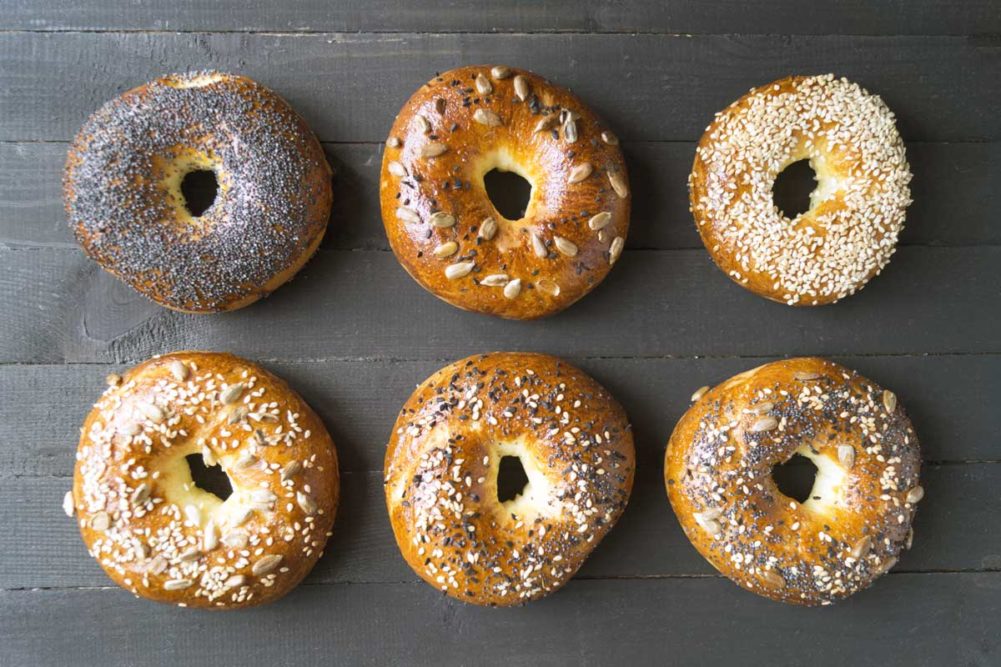While there are new flavor and ingredient combinations popping up throughout the bagel market, innovation has been mostly muted.
“Bagel product launches in the United States in 2019 came in at just over half the rate of innovation as recently as 2016,” said Tom Vierhile, vice president, strategic insights for North America, Innova Market Insights. “For whatever reason, bagels are not setting the world on fire, at least from the perspective of packaged bagels sold in supermarkets, mass-merchandisers, etc.”
But, he said, there is a lot of white space when it comes to flavor innovation, and that bagel marketers should target seasonal or limited-time offerings. According to a 2019 Innova Trends Survey, 64% of Americans say they love trying limited edition or seasonal flavors.
“Flavors like cranberry certainly hit the seasonal button, while stuffed bagels represent more adventurous flavor innovation,” Mr. Vierhile said.
Bantam Bagels, New York, introduced frozen stuffed mini bagels in 2013. The mini bagels come six in a carton box and have a shelf life of five days refrigerated or one year frozen. To prepare them at home, consumers just defrost the bagels in the refrigerator overnight, then toast.
[Related reading: Wake-N-Bagels delivers ‘fresh-out-of-the-oven experience’ to consumers]
Tim Grzebinski, principal, client insights, IRI, pointed out that impactful flavors can drive incremental sales in the bagel category, especially those that showed strong growth in 2019 like everything, cinnamon raisin, cinnamon swirl and blueberry.
“There may be opportunity for bagels to win with unique flavor varieties to try and capture more occasions throughout the day, as well as capture seasonal sales trends,” Mr. Grzebinski said.
BigY, Chicopee, Mass., launched the seasonal Taste of the Season Cranberry Bagels for winter holidays. The packages came with six naturally and artificially flavored cranberry bagels. Franz Bakery, Portland, Ore., launched Blueberry Chia Premium Bagels that are organic, vegan, non-GMO and naturally flavored.
While these creative twists might provide glimmers of innovation, they also need to reach consumers through the right channel. Traditionally, that might’ve been the grocery story. Today, it’s often e-commerce.
The new bagel consumer market
The coronavirus (COVID-19) pandemic changed the baked goods market for the foreseeable future. Spikes in online sales settled a bit through April, but there is still significant growth in the bagel category as consumers continue to eat at home.
“E-commerce was already capturing the vast majority of omnichannel growth and has gained further momentum given the recent pandemic,” Mr. Grzebinski said.
In the last four weeks of March, online bagel sales grew 133% vs. the same period a year ago, according to IRI. That outpaced the total online growth for edibles of 86.8%.
“It is critical that CPG companies have a solid online strategy to capitalize on this trend to maximize their growth goals,” Mr. Grzebinski said. “With unemployment being at an all-time high as well, it will also be important that price, promotion and value offerings are available to meet a potential shift in consumer behavior.”
Bagels may be a go-to for more people moving into the rest of 2020. And there are several key drivers that producers should be aware of as the market continues to shift. Looking forward, Mr. Grzebinski said, bakers should continue to expect higher sales numbers.
[Related reading: Pandemic pushes e-commerce back into spotlight]
Even as many states reopened their economies in May, consumers may still be reluctant to go to restaurants for the near future. This bodes well for packaged bagel retail sales.
“We know many consumers are trying to minimize their retail trips, so we have seen larger baskets and increased purchase cycles,”
Mr. Grzebinski said. “Some consumers are purchasing larger product sizes and freezing to save for future use, too.”
In April, as the sales spike settled, bagel dollars were still up 30.7% vs. the same period a year ago within multi-outlet stores and c-stores.
What’s made bagels such a popular product over the decades is what will keep them relevant in the 2020 economy, and beyond. Bagels are products that work well when purchased fresh, refrigerated or frozen. Because of this,
Mr. Vierhile said they are well positioned to prosper in a time of great uncertainty.
“Bagels may also benefit from the perception that they represent comfort food to some, and we are definitely seeing a big push toward all types of comfort foods today,” Mr. Vierhile said.
Combine that with fewer carbs, increased protein and the inclusion of seasonal or natural flavors and ingredients, and bagels will keep the wheels turning as they always have.
This article is an excerpt from the June 2020 issue of Baking & Snack. To read the entire feature on bagels, click here.






